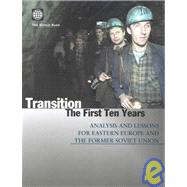
| Foreword | ix | ||||
| Acknowledgments | xi | ||||
| Overview | xiii | ||||
| The Quest for Growth: Promoting Discipline and Encouragement | xv | ||||
| The Flipside: Protection and Discouragement | xvii | ||||
| Shading the Classification | xvii | ||||
| New Enterprises Spur Economic Growth | xviii | ||||
| When Is Transition Over? | xix | ||||
| Do Central Europe and the Baltics Point the Way Forward? | xix | ||||
| Can We Have It Both Ways: Encouragement without Discipline? | xx | ||||
| Learning from China? | xxi | ||||
| Institutions Are Important, but So Are Policies | xxi | ||||
| The Political Economy of Discipline and Encouragement | xxii | ||||
| Shifting Policy Priorities to Account for Experience and New Conditions | xxiv | ||||
| Conclusions | xxviii | ||||
| Annex 1. Discipline and Encouragement: The Reform Agenda | xxix | ||||
| Part 1. The First Decade in Transition | 1 | (20) | |||
|
3 | (8) | |||
|
3 | (2) | |||
|
5 | (1) | |||
|
6 | (1) | |||
|
6 | (1) | |||
|
6 | (5) | |||
|
11 | (10) | |||
|
11 | (2) | |||
|
13 | (1) | |||
|
13 | (2) | |||
|
15 | (1) | |||
|
16 | (1) | |||
|
16 | (1) | |||
|
16 | (3) | |||
|
19 | (2) | |||
| Part 2. Policy and Institutional Challenges Ahead | 21 | (68) | |||
|
23 | (10) | |||
|
26 | (3) | |||
|
29 | (1) | |||
|
30 | (3) | |||
|
33 | (20) | |||
|
39 | (2) | |||
|
41 | (4) | |||
|
45 | (3) | |||
|
48 | (2) | |||
|
50 | (3) | |||
|
53 | (6) | |||
|
53 | (1) | |||
|
54 | (2) | |||
|
56 | (1) | |||
|
56 | (3) | |||
|
59 | (12) | |||
|
59 | (2) | |||
|
61 | (1) | |||
|
62 | (5) | |||
|
67 | (1) | |||
|
67 | (1) | |||
|
68 | (3) | |||
|
71 | (10) | |||
|
73 | (1) | |||
|
73 | (5) | |||
|
78 | (1) | |||
|
79 | (2) | |||
|
81 | (8) | |||
|
81 | (2) | |||
|
83 | (1) | |||
|
84 | (2) | |||
|
86 | (3) | |||
| Part 3. The Political Economy of Discipline and Encouragement | 89 | (28) | |||
|
91 | (6) | |||
|
92 | (2) | |||
|
94 | (3) | |||
|
97 | (6) | |||
|
99 | (2) | |||
|
101 | (2) | |||
|
103 | (8) | |||
|
105 | (2) | |||
|
107 | (4) | |||
|
111 | (6) | |||
|
112 | (2) | |||
|
114 | (1) | |||
|
115 | (1) | |||
|
115 | (1) | |||
|
116 | (1) | |||
| Selected Bibliographic Guide to the Political Economy of Transition | 117 | (8) | |||
| References | 125 |
The New copy of this book will include any supplemental materials advertised. Please check the title of the book to determine if it should include any access cards, study guides, lab manuals, CDs, etc.
The Used, Rental and eBook copies of this book are not guaranteed to include any supplemental materials. Typically, only the book itself is included. This is true even if the title states it includes any access cards, study guides, lab manuals, CDs, etc.